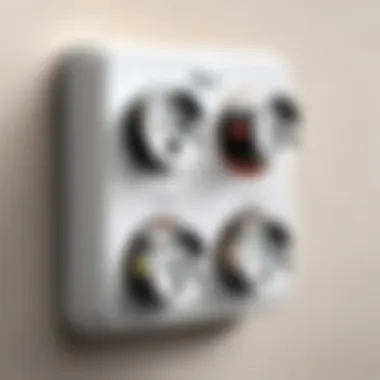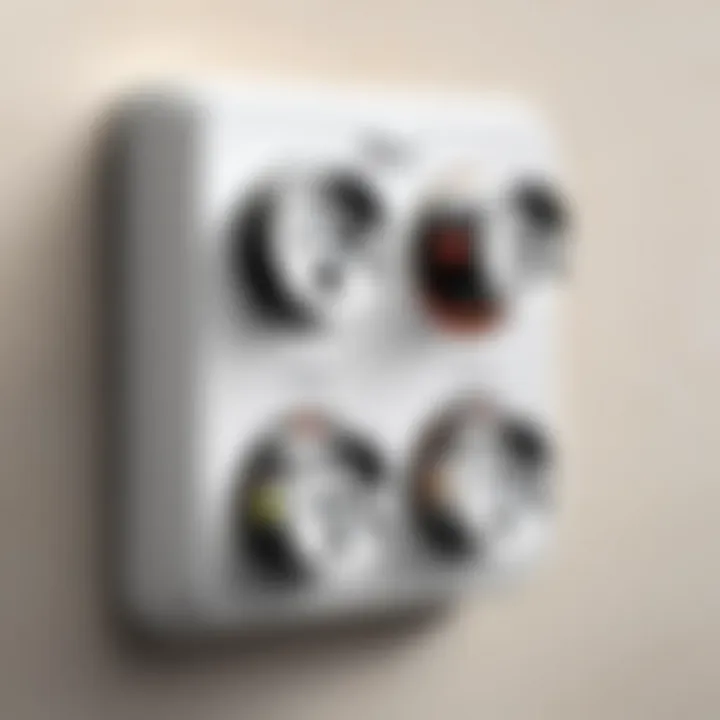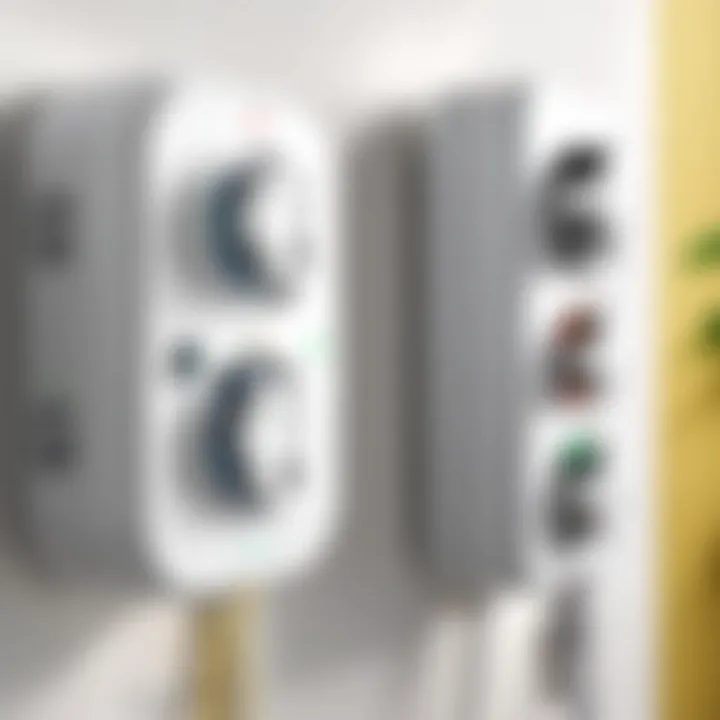Thermostatic Smart Plugs: A New Era in Energy Management


Intro
In recent years, the demand for efficient energy management has increased significantly. This trend has been fueled by rising energy costs and a growing awareness of environmental sustainability. Among the solutions emerging in this space are thermostatic smart plugs, which promise to enhance how we manage our energy consumption in homes and offices. These devices represent a significant shift from traditional plugs, offering advanced functionalities that support smarter and more efficient energy use.
Thermostatic smart plugs enable users to control their energy consumption from anywhere. With the integration of Wi-Fi and smart technology, individuals can monitor and adjust power usage through their smartphones or voice-activated assistants. This capability is not just about convenience but also about optimizing energy efficiency. As we delve deeper into this topic, we will explore the essential features of thermostatic smart plugs, how they perform in real-world scenarios, and their role in the broader context of smart home systems.
The journey into understanding thermostatic smart plugs will reveal not only their immediate benefits but also their implications for future energy management practices. As the trend towards automation and smart technology continues to grow, these devices are set to play a crucial role in transforming how we approach energy conservation.
Understanding Thermostatic Smart Plugs
Thermostatic smart plugs are emerging as integral components in modern energy management solutions. They represent a significant shift in how individuals and businesses control and optimize energy usage. As awareness about energy consumption rises, understanding these devices becomes essential. Not only do they provide convenience, but they also aid in achieving energy efficiency and sustainability goals.
These plugs are equipped with sensors and smart technology that allow users to regulate the temperature and manage devices from afar. This section aims to unpack the definitions and functionalities of thermostatic smart plugs, as well as their key features, which facilitate their widespread adoption.
Definition and Functionality
A thermostatic smart plug is a device that connects to a standard electrical outlet and enables the user to control connected appliances remotely. This functionality is largely enabled by built-in sensors that monitor temperature and may help manage the energy consumption of connected devices. For example, a user can set their thermostat to switch a heater on or off based on real-time temperature readings, effectively optimizing performance and reducing waste.
Key Features
Temperature Regulation
Temperature regulation is a primary attribute of thermostatic smart plugs. This feature allows users to maintain desired temperature levels within a space. It not only enhances comfort but also promotes energy savings. By regulating temperature settings precisely, users can minimize unnecessary heating or cooling, leading to lower energy consumption.
A unique characteristic of temperature regulation is its ability to adapt in real time. This can be particularly beneficial during seasonal changes. However, a disadvantage might be the reliability of the sensors that could be affected by extreme ambient conditions.
Remote Control Access
Remote control access allows users to manage their appliances from any location using a smartphone application or web interface. This capability is highly beneficial as it provides the flexibility to adjust settings when away from home. For instance, if a user forgets to turn off a space heater, they can do so remotely, helping to prevent emergencies.
The appeal of this feature lies in its convenience, although a drawback could be the dependency on stable internet connectivity for remote functionality, which could pose challenges in some situations.
Integration Capabilities
Integration capabilities refer to the ability of thermostatic smart plugs to work with various smart home ecosystems. Many devices can connect easily to systems like Amazon Alexa, Google Home, or Apple’s HomeKit. This compatibility allows for seamless automation and control alongside other smart devices.
A prominent advantage of integration is the potential for creating customized routines that enhance user experience. However, compatibility issues can arise with certain devices, leading to frustrations that may hinder user satisfaction.
By understanding these two elements—defining the devices and exploring their key features—users can better appreciate the role of thermostatic smart plugs in energy management. Their unique functionalities promote not just efficiency but also convenience in today's fast-paced digital environment.
The Technology Behind Thermostatic Smart Plugs
The technology behind thermostatic smart plugs is essential for understanding how these devices function and their benefits in energy management. This section explores the key components that enable thermostatic smart plugs to provide effective temperature regulation and connectivity, ultimately enhancing user experience and energy efficiency.
Sensors and Connectivity
Temperature Sensors
Temperature sensors are critical in the operation of thermostatic smart plugs. They help monitor and regulate the surrounding environment temperature accurately. A key characteristic of temperature sensors is their sensitivity. This attribute allows them to detect even small fluctuations in temperature, ensuring that devices connected to the smart plug operate optimally. This characteristic makes them a popular choice in smart home technologies.
One unique feature of temperature sensors is their ability to provide real-time data. This means users can receive immediate updates about the temperature conditions in their home through connected apps. The main advantage of this feature is that it allows for timely adjustments, promoting energy efficiency. However, one disadvantage could be potential inaccuracies caused by external factors, such as drafts or placement near heat sources. This nuance is important to consider in effective home energy management.
Wi-Fi and Bluetooth Integration
Wi-Fi and Bluetooth integration plays a vital role in the functionality of thermostatic smart plugs. These connections allow devices to communicate over the internet and with each other, which enhances their ability to work seamlessly within a smart home ecosystem. A key characteristic of this technology is its versatility. Both Wi-Fi and Bluetooth have their specific advantages depending on the user’s needs.
For instance, Wi-Fi offers a broader range and supports multiple devices, making it beneficial for larger homes. On the other hand, Bluetooth generally consumes less power, which is an attractive aspect for users concerned about energy costs. A unique feature of this integration is its ease of installation. Users often find setting up Wi-Fi or Bluetooth connectivity straightforward, allowing for quick access to smart home features. The disadvantage, however, might be potential connectivity issues. Wifi signals can fluctuate based on the router's strength and location, which may disrupt use in certain areas of a home.
User Interface and Control Apps
Smartphone Applications
Smartphone applications are integral for managing thermostatic smart plugs. They offer users a convenient way to control and monitor their devices remotely. One key characteristic of these applications is their user-friendly design. Many apps are designed with intuitive interfaces that make navigation simple, which appeals to both tech-savvy users and those less experienced with technology.
In addition, smartphone applications often provide valuable features like scheduling and alerts. This capability allows users to set specific times for devices to operate, optimizing energy use as needed. The key advantage of smartphone applications is that they provide continuous access, meaning users can adjust their settings from anywhere. A potential disadvantage, however, can arise if the app requires constant internet access, limiting control during outages or connectivity interruptions.
Voice Command Integration
Voice command integration represents a significant advancement in how users interact with thermostatic smart plugs. This technology allows users to control their devices using simple voice commands, enhancing convenience. A key characteristic of voice command integration is its compatibility with popular voice assistants like Amazon Alexa or Google Assistant. This makes it a popular choice among consumers who prefer hands-free operation.
One unique feature of this technology is its ability to facilitate multitasking. Users can manage their devices without needing to engage physically with their smartphones or other controls, which aligns well with busy lifestyles. However, limitations exist. The effectiveness of voice command can depend on the clarity of speech and the ambient noise level, which might affect usability in certain situations. Despite this, voice integration continues to be a favorable option for many users looking for added convenience in energy management.


Advantages of Using Thermostatic Smart Plugs
Thermostatic smart plugs offer numerous advantages that make them an important component in modern energy management systems. Understanding these benefits can greatly influence the decision-making process for consumers and professionals alike. By integrating these devices into everyday life, users can optimize energy consumption, reduce costs, and enhance overall comfort within their environments.
Energy Efficiency
One of the main benefits of thermostatic smart plugs is energy efficiency. These devices monitor and control the energy usage of connected appliances based on real-time temperature readings. The ability to adjust energy consumption automatically leads to significant reductions in waste. As energy costs continue to rise, making smarter choices about energy use becomes paramount.
- Smart Scheduling: Users can program the plugs to operate appliances during off-peak hours, utilizing lower energy rates where applicable.
- Adaptive Performance: The plugs can learn user habits over time, automatically adjusting settings to optimize performance and energy savings.
Cost Savings
Long-term Financial Benefits
The long-term financial benefits of using thermostatic smart plugs are substantial. While there may be an initial investment, the savings realized over time can easily outweigh these costs. One key characteristic of this benefit is the potential for reduced reliance on utility services.
- Decreased Energy Dependency: By effectively managing energy use, users may find that they require less energy from their utility provider, translating into lower bills.
This makes thermostatic smart plugs a favorable choice for individuals looking to improve their financial situation while supporting sustainable practices.
Reduction in Energy Bills
The reduction in energy bills is a critical aspect that speaks to the efficacy of thermostatic smart plugs. Many users report noticeable decreases in their monthly expenses after installing these devices. A significant feature of this reduction involves real-time analytics, which helps users understand their usage patterns.
- Targeted Control: Users can track which devices consume the most energy and modify their usage accordingly.
- Empowering Users: With detailed insights, consumers are more likely to make informed energy decisions that lead to further savings.
Convenience and Comfort
Finally, the convenience and comfort provided by thermostatic smart plugs cannot be underestimated. These devices facilitate a more manageable home environment, allowing for better control over temperature and energy use remotely. Users can prioritize their comfort by easily adjusting settings through connected smartphone applications or voice commands.
The ability to automate control based on individual preferences presents an opportunity for improving daily life. For example, programmers can set schedules that align with the household's routine, ensuring that appliances operate only when needed.
In addition, the simplicity of installation and user interface design means that even those with minimal technical knowledge can benefit from these innovations.
"Using thermostatic smart plugs transforms the way we manage energy; not only do they help in saving costs but also enhance the convenience of our lifestyles."
Installation of Thermostatic Smart Plugs
The installation of thermostatic smart plugs is a critical aspect in realizing their benefits for energy management. Proper installation ensures not only optimal performance but also adds convenience and safety to the user’s environment. The steps leading up to the installation process can also impact the overall efficacy of the smart plug, hence it’s essential to understand what is required beforehand.
Pre-Installation Requirements
Assessing Electrical Outlets
Understanding the electrical outlets in your home is crucial. Each outlet should be examined to determine if it is suitable for a thermostatic smart plug. Look for signs of wear, damage or incompatibility. It is beneficial to have outlets that are grounded to avoid electrical hazards. This assessment enhances safety and reliability, allowing the smart plug to function as intended.
A key characteristic of assessing electrical outlets is ensuring they are within the right voltage range. Most thermostatic smart plugs operate at 120 volts, which is standard in many homes. If there is a mismatch, it can lead to overheating or failure of the device. Such a misalignment is a significant drawback when considering the advantages of energy management, as it could lead to wasted energy or even irreversible damage to the plug.
Choosing Compatible Devices
Another important step involves selecting compatible devices for the thermostatic smart plugs. Not all appliances can benefit from smart control, so it’s essential to ensure that your devices can integrate seamlessly. This involves checking if the devices meet the energy ratings specified by the smart plug manufacturer.
Choosing compatible devices highlights the significance of understanding load capacity. A common mistake is to overlook the power consumption of connected devices, which could lead to overloading the smart plug. This could result in safety risks and even device malfunction. Therefore, verifying compatibility before installation is a prudent decision for anyone looking to maximize the potential of their energy management setup.
Step-by-Step Installation Guide
Here is a straightforward guide to installing thermostatic smart plugs:
- Prepare the Area: Ensure that you have a clean working area around the outlet where the smart plug will be installed.
- Check Device Compatibility: Confirm that the devices you plan to connect to the smart plug are compatible.
- Plug in the Thermostatic Smart Plug: Insert the smart plug into the electrical outlet without forcing it.
- Connect to Wi-Fi: Follow the manufacturer’s instructions to connect the plug to your home Wi-Fi network using a mobile application.
- Setup Device Management: Use the app to set up schedules and temperature preferences according to your needs.
- Test Functionality: Once everything is set up, perform a test run to ensure all settings are accurately implemented.
"Proper installation is critical for maximizing the efficiency of thermostatic smart plugs and ultimately conserving energy."
Market Trends and Innovations
Thermostatic smart plugs are part of a rapidly evolving technology landscape that transforms how we manage energy consumption in our homes and offices. Understanding the latest market trends and innovations is essential for IT professionals and tech enthusiasts who seek to leverage these devices effectively. The sophistication in features, connectivity options, and integration capabilities of these devices reflects a growing focus on sustainability and user-friendly technology solutions. As the demand for smart home technology increases, staying abreast of these trends can lead to better decision-making when selecting products that enhance energy efficiency and convenience for users.
Current Market Landscape
Thermostatic smart plugs have entered a competitive market that showcases significant growth. This growth stems from several factors, including rising energy costs, increased awareness of environmental issues, and advancements in the Internet of Things (IoT). The market is characterized by a variety of brands offering different functionalities, pricing structures, and compatibility with other smart home devices.
Consumers are prioritizing devices that offer both energy savings and ease of use. Many brands are integrating features such as scheduling and real-time energy monitoring, which cater to the modern user’s need to maintain control over their energy consumption. Research indicates that households that utilize smart plugs see a noticeable reduction in their overall energy spend, driving further interest in this technology.


Emerging Technologies
Innovations in thermostatic smart plugs have led to two notable advancements worth discussing: integration with renewable energy sources and artificial intelligence in control systems.
Integration with Renewable Energy Sources
Integration with renewable energy sources refers to the ability of thermostatic smart plugs to work in harmony with solar panels or other sustainable energy solutions. This aspect highlights a vital trend towards green energy initiatives. By managing energy consumption based on the availability of renewable power, users can optimize their energy usage and potentially lower their utility bills significantly.
A key characteristic of this integration is its capacity to reduce reliance on fossil fuels during peak consumption times. For instance, when solar power production is high, thermostatic smart plugs can automatically switch on devices, ensuring that energy produced is used effectively. However, while this feature is beneficial, it requires careful consideration of setup and ongoing management to maximize the advantages.
Artificial Intelligence in Control Systems
Artificial intelligence in control systems enhances the functionality of thermostatic smart plugs through machine learning algorithms that analyze user behavior. These systems can adapt to the individual preferences and patterns of users, ultimately providing more personalized energy management solutions. The ability to learn and predict usage patterns represents a leap forward in user-centric technology.
One of the unique features of AI integration is its ability to remotely optimize energy consumption. With proper settings, the system can adjust device operations based on energy cost fluctuations or availability of renewable energy sources. This leads to significant reduction in energy waste and improved convenience for users. As beneficial as it can be, concerns exist regarding data privacy and the reliance on automated processes for energy management.
In summary, the market trends surrounding thermostatic smart plugs highlight innovative integrations that empower consumers to manage their energy needs more efficiently while promoting sustainable practices.
Overall, the advancements in this market indicate a bright future for thermostatic smart plugs, shaped by emerging technologies that prioritize efficiency, user customization, and environmental responsibility.
Comparison with Traditional Plugs
In order to understand the impact and advancements thermostatic smart plugs offer, it is beneficial to compare them with traditional plugs. Traditional plugs provide a basic function, simply allowing electrical devices to connect to power sources. However, their limitation lies in their lack of intelligence or adaptability. This lack of capability means they don't monitor nor manage energy consumption effectively, leading to inefficiencies.
Functionalities
The functionalities of thermostatic smart plugs are what set them apart from traditional alternatives. Unlike conventional plugs, these smart plugs provide automatic temperature regulation, remote control access, and enhanced integration capabilities with smart home systems.
Some functionalities that are particularly notable include the ability to program schedules. This allows users to set when devices are powered on or off based on their needs, such as preheating or cooling a space before arriving home.
- Temperature Regulation: This feature allows smart plugs to monitor the ambient temperature and adjust device performance accordingly. For example, when a heater is plugged into a thermostatic plug, it can automatically turn off if a set temperature is reached.
- Remote Control Access: Users can control their devices from anywhere through a smartphone. This flexibility adds a layer of convenience that traditional plugs can’t offer.
- Integration Capabilities: Thermostatic smart plugs can communicate with other devices in a smart home ecosystem. This means synchronization with smart thermostats, lights, or security systems to create an efficient home environment.
Overall, the functionalities of thermostatic smart plugs significantly enhance user control over their energy consumption, promoting intelligent energy management.
Performance Metrics
The performance metrics of thermostatic smart plugs can be analyzed through the lenses of energy consumption and user experience.
Energy Consumption
Energy consumption is a critical metric when assessing the benefits of thermostatic smart plugs. These devices are designed to minimize waste by ensuring that appliances are only powered when necessary.
- Key Characteristic: One significant aspect of energy consumption is the ability to track and analyze energy use through connected applications. Users are able to monitor how much energy devices consume over time, which promotes more conscientious usage.
- Why It Is a Beneficial Choice: By efficiently managing energy, users can expect a reduction in their overall energy bills, which aligns well with broader sustainability goals.
- Unique Feature: Many smart plugs offer Energy Monitoring settings, which provide real-time updates on power usage. This feature helps users learn and adjust their habits, enhancing the long-term benefits of using these devices.
User Experience
User experience is another essential metric. Effective use of thermostatic smart plugs can significantly improve how individuals interact with technology in their daily lives.
- Key Characteristic: Convenience is paramount. Users benefit from controlling devices remotely, rather than walking to the outlet to unplug an appliance. This is a major upgrade from traditional plugs.
- Why It Is a Beneficial Choice: The streamlined interaction with technology creates a more efficient home environment. Once set up, users often find a marked improvement in their routine.
- Unique Feature: Many smart plugs are compatible with voice-activated systems, allowing for hands-free operation. This aspect not only makes them convenient but also accessible for individuals with mobility restrictions.
Challenges and Limitations
Understanding the challenges and limitations surrounding thermostatic smart plugs is essential for an accurate assessment of their role in energy management. While these devices offer numerous benefits, they also present various obstacles that can hinder their widespread adoption. Addressing these challenges can help potential users make informed decisions and adapt to new technology more seamlessly.
Technical Limitations
Thermostatic smart plugs often face certain technical limitations that can affect their performance and reliability. One primary concern is the dependence on stable internet connections. Many smart plugs require continuous Wi-Fi connectivity to function optimally. If the internet is slow or unavailable, this can lead to ineffective temperature regulation and hinder usability.
Additionally, compatibility can be an issue. Not all smart plugs can work with every home system or device. This lack of universal standards might make setup complicated and frustrating for some users. If they are unable to integrate properly with existing smart home technologies, users may not be able to fully utilize the benefits these devices offer.
User Adoption Barriers
User adoption barriers further complicate the situation. Despite their advantages, many potential users hesitate to invest in thermostatic smart plugs. Understanding these barriers helps clarify the gap between potential and actual usage.
Cost Concerns
Cost concerns are significant for many users considering thermostatic smart plugs. While these devices can result in long-term savings on energy bills, their initial purchase price can be a deterrent. Users may question whether the upfront investment will yield sufficient savings in their specific situation.
Moreover, the market offers a variety of brands and models at different price points, which can lead to confusion. Navigating through selections that range wildly in terms of features and pricing can be overwhelming. This aspect makes it crucial for consumers to conduct thorough research before committing.
Technical Knowledge Requirements


Another barrier to user adoption is the level of technical knowledge required to operate thermostatic smart plugs effectively. Many users may find the setup process daunting, especially if they have limited experience with technology. They need to understand how to connect these devices to their home networks and mobile applications.
This challenge can be a significant hurdle for older individuals or those not accustomed to smart technology. An easier user experience could enhance adoption rates significantly. Providing clearer instructions and support could bridge this gap.
Practical Applications in Daily Life
Thermostatic smart plugs have become integral to modern energy management systems. This technology offers numerous practical applications that are valuable for users seeking efficiency and convenience in their daily lives. By automating the functionality of home appliances, it allows users to manage energy consumption more effectively.
This section elaborates on two significant applications of thermostatic smart plugs: home automation and energy monitoring. These applications not only enhance comfort in everyday living but also contribute to long-term energy savings.
Home Automation
Home automation is one of the most prominent uses of thermostatic smart plugs. These devices can be programmed to control various electrical appliances based on temperature settings or schedules. For instance, a smart plug can automate a space heater to turn on when the room temperature drops below a certain threshold. This ensures the living environment remains comfortable without manual intervention.
In addition to basic temperature control, integration with other smart home devices is a notable feature of thermostatic smart plugs. Systems such as Google Home or Amazon Alexa can be leveraged to create a cohesive smart home ecosystem. Users can control multiple appliances using voice commands, which offers a seamless experience.
Key elements of home automation with smart plugs include:
- Scheduling: Users can set specific times for appliances to operate, avoiding energy wastage.
- Remote Control: Users can manage appliances from anywhere, adding an extra level of convenience.
- Automation: Combining with motion detectors or smart sensors enhances functionality and user experience.
Energy Monitoring
Energy monitoring through thermostatic smart plugs allows users to track electricity consumption in real time. This capability provides insights into which devices consume the most energy, enabling users to make informed decisions about their energy usage.
Many smart plugs come equipped with energy monitoring features, providing a breakdown of power consumption through associated mobile applications. This information can help identify patterns and times of high usage, enabling proactive management of energy resources.
The benefits of energy monitoring are clear:
- Identifying Energy Hogs: Users can pinpoint which devices guzzle electricity, allowing for targeted interventions.
- Budgeting: Understanding energy costs helps users create realistic budgets for utilities.
- Promoting Energy Savings: With data on energy use, users can adjust habits to reduce overall consumption, directly impacting household bills.
Future of Thermostatic Smart Plugs
The future of thermostatic smart plugs is integral to the ongoing evolution of energy management systems. As households and businesses increasingly focus on sustainability, these devices are transforming how we consume and manage energy. Their importance lies not only in enhancing convenience but also in reducing energy wastage. In this section, we will explore the predicted trends in smart home integration and improvements in user interfaces, while discussing their implications for energy management.
Predicted Trends
Smart Home Integration
Smart home integration refers to the capability of thermostatic smart plugs to connect seamlessly with other smart devices in a home ecosystem. This characteristic makes them highly beneficial for creating cohesive energy management solutions. The unique feature of these plugs is their ability to communicate with devices such as smart thermostats, lights, and security systems, leading to enhanced energy efficiency and convenience. By synchronizing multiple devices, users can ensure optimal energy usage, effectively managing power consumption throughout their homes.
- Benefits of smart home integration include:
- Centralized Control: Users can operate various devices from a single app or platform.
- Automated Energy Savings: Devices can adjust settings automatically based on usage patterns, reducing unnecessary energy consumption.
- Enhanced User Experience: Greater ease of use fosters user engagement, essential for long-term adoption.
However, challenges exist, such as compatibility issues among devices from different manufacturers. Ensuring that all devices can communicate effectively is vital for maximizing the potential of smart home integration.
Improved User Interfaces
The enhancement of user interfaces is another key trend shaping the future of thermostatic smart plugs. Modern interfaces prioritize simplicity and accessibility, making it easier for users to navigate and control their devices. A notable characteristic of improved user interfaces is their responsiveness and customization options, allowing users to tailor functionalities to their preferences.
- Key features of improved user interfaces include:
- Intuitive Design: Clear layouts and straightforward navigation improve accessibility.
- Quick Access to Features: Users can easily find and operate essential functions, which boosts engagement.
- Real-Time Data Visualization: Displaying energy consumption data enables informed decision-making about energy use.
Despite these advances, some users may encounter a learning curve when adapting to new technologies. Effective onboarding and support resources are crucial to overcome this barrier.
Implications for Energy Management
Thermostatic smart plugs have significant implications for energy management strategies. With the projected advancements in integration and user interaction, these devices empower users to take complete control of their energy usage. The ability to monitor consumption in real-time fosters a sense of accountability, encouraging environmentally responsible behavior. As these devices become more prevalent, they can significantly contribute to overall energy reduction efforts across industries.
"The future of energy efficiency lies not merely in tool adoption but in user engagement and education."
As the technology evolves, businesses and consumers alike must stay informed about the developments in thermostatic smart plugs to fully leverage their potential. This ongoing engagement will shape the dialogue around sustainable energy management in the years to come.
Closure
The conclusion serves a pivotal role in wrapping up the exploration of thermostatic smart plugs. It synthesizes the key points discussed across various sections, providing clarity on the implications of these devices for energy management and efficiency.
Summary of Findings
Thermostatic smart plugs amalgamate technology with energy efficiency, offering a variety of benefits for everyday consumers and businesses alike. They provide essential functionalities such as remote control capabilities, temperature regulation, and integration with existing smart home systems. Their advanced features contribute to significant energy savings and cost reductions over time, making them an appealing choice for those looking to enhance their energy management strategies. The potential for these devices to evolve with emerging technologies, including renewable energy sources and artificial intelligence, further emphasizes their relevance in the future landscape of smart home systems.
Moreover, the challenges and limitations faced in adoption cannot be overlooked. Technical barriers, along with consumer hesitance related to costs and complexity, present hurdles that require resolution.
Call to Action for Consumers
Now is a crucial moment for consumers to embrace the shift towards energy-efficient solutions. Investing in thermostatic smart plugs can lead to a more sustainable lifestyle while delivering tangible financial benefits. Consumers should actively seek out compatible devices that fit within their home automation systems, evaluate their specific energy needs, and leverage technology to maximize efficiency.
Potential users are encouraged to explore various brands and models, review consumer feedback, and consider future-proofing their investments. The potential for thermostatic smart plugs to transform energy management should not be underestimated. By taking proactive steps toward incorporation of these innovative devices, individuals can position themselves at the forefront of energy consciousness and smart technology implementation.



